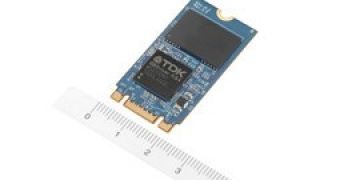Most solid-state drives in the world are made from MLC (multi-level cell) NAND Flash chips, which are pretty cheap compared to SLC, but not as enduring, among other things. TDK went for the kill when it made the SNG4A line though.
By that we mean that the company used single-level cell NAND to produce the SNG4A line of solid-state drives.
That's just half of what makes them unusual though. The other reason they can be called that is the part where the SSDs use the M.2 form factor.
Also known as NGFF (next-generation form factor), M/2 describes those SSDs that are small enough to fit inside mini PCI Express slots.
The drives also happen to be very, very small, and to have the connector on one of the narrow sides, not the long one (unlike on normal PCI Express SSDs).
The newcomers all use TDK's own SSD controller chips and should be able to process commands up to the Serial ATA Revision 2.6 Specification just fine.
The GBDriver RS4 chip boasts a power interruption tolerance algorithm that allows the M.2 SSD to survive power failures or fluctuations without suffering any harm. Even the data will be saved in instances of energy drops.
It makes the SNG4A SSDs very well suited to industrial applications, though laptops will benefit just as much.
Or they would benefit, if not for the little snag that these are SLC drives, which cost a lot more than normal ones, even other M.2 products.
We won't really know the prices until May 14-16 though, when the newcomers will be showcased at the Embedded Systems Expo (ESEC).
Moving on, TDK has also installed 128-bit AES encryption (pretty self-explanatory by this point), and service life diagnosis software (TDK SMART).
It's a shame that TDK did not say what read and write speeds the newcomers boasted. We suppose we have to wait until mid-month for that as well.
At least we know that, if nothing else, the newcomers will be unchallenged in regard to size. It's hard to get any smaller than 22 x 42 mm / 0.86 x 1.65 inches after all, and maybe TDK will even unveil a higher-capacity model, even if it does have to switch from SLC to MLC to attain 120-128 GB. If it does happen, however, it will probably be a few weeks or months from now, give or take one or two.

 14 DAY TRIAL //
14 DAY TRIAL //